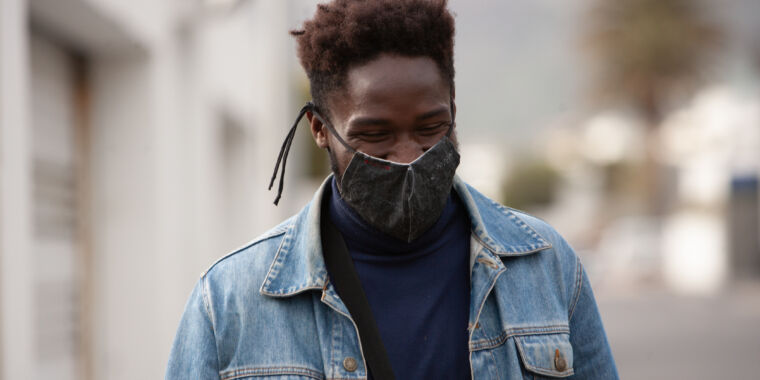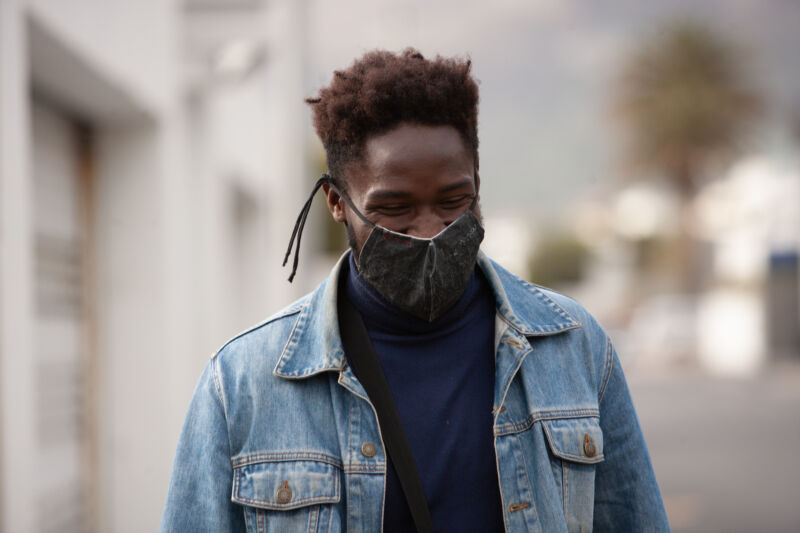
This past March, we updated this face mask buying guide with the latest guidance from the Centers for Disease Control and Prevention (CDC), including new science on the increased effectiveness of double-masking. Vaccinations had just started rolling out, and we were on the precipice of what many hoped would be a “return to normal,” only for the public to be swiftly reminded that SARS-CoV-2, the virus that causes COVID-19, continues to circulate, mutate, and claim lives.
The omicron variant is the latest variant of concern, following late-summer and early-winter surges in US COVID cases spurred by the highly contagious delta variant. Early studies of omicron indicate that it’s even more transmissible—and potentially more likely to cause breakthrough infections in vaccinated people. The Biden administration has released new plans to combat rising infections and the emergent omicron variant. Naturally, proper masking is key.
Heading into the holidays with all of this in mind—and with generally improved conditions in the global supply of personal protective equipment (PPE)—we thought now would be a good time for a booster on mask knowledge. Our newly updated mask guide includes information on how to double-mask effectively, how to reuse KN95 and N95 masks safely, how to maximize a surgical mask’s effectiveness, how to choose and clean great cloth masks, and more. Below are our latest picks based on product availability and long-term testing.
Ars Technica may earn compensation for sales from links on this post through affiliate programs.
The TL;DR version
- Our favorite N95 mask: The supply shortage on medical masks has lessened, making non-medical N95 masks sensible and highly effective options for the general public, particularly those at high risk of illness. Of the various models we’ve tested, we like Fangtian’s N95 face masks. They fit like a glove, they’re legitimately made and certified, and they’re available at reasonable prices.
- A good KN95 mask: Alternatively, Arun’s KN95 masks have been tested to the same filtration standard of N95s and offer easier use for lower-risk situations. There’s a ton of KN95s on the market that can vary in areas other than filtration, so we picked one with a strong nose wire and more form-fitting construction.
- Another worthy option: The new American Society for Testing and Materials (ASTM) standard for filtration and breathability in non-medical masks led us to a great KN95 alternative in 3M’s Advanced Filtering Face Mask. It has a high filtration efficacy, and it’s a better choice for smaller face types than our KN95 pick.
- Our favorite cloth mask: Kenneth Cole’s Woven Face Mask remains our top pick for an everyday cloth mask. It has all the properties of a good cloth mask, according to CDC and WHO guidelines. With multilayer construction (including a middle filter layer), a nose wire, and adjustable ear loops, it checks all the boxes and achieves a decent fit. It is machine-washable in hot water.
- Alternative cloth masks we like: If you don’t mind swapping out a replaceable filter, the Outdoor Research Face Mask Kit offers the best fit of all the masks we’ve tested, with a longer, sturdier nose wire and a shape that wraps around the chin and cheeks to close up air gaps. It requires disposable filters if you wear it alone, but the snug fit also makes it our top pick for double-masking. Kitsbow’s Reusable Face Mask with HEPA Type Filter, meanwhile, is a good alternative with many of the same strengths and two more size options. It uses head straps instead of ear loops, though, which can be cumbersome in situations where you want to remove your mask from time to time.
- A great mask for working out: If you’re interested in a mask you can wear while exercising, the UA Sportsmask by Under Armour has all the layers you need while still being breathable, comfortable, and moisture-wicking. It won’t get in the way, relatively speaking, while you’re breathing heavily.
- More accessible options for kids and those hard of hearing: We’ve also found some homemade masks from Etsy that integrate proper layering and come with kid-friendly designs or clear windows for lip-reading.
- Useful mask accessories: Whether you’re using disposable medical masks or a cloth option, cord locks or a mask-fitting brace can aid your fit and the filtration efficacy of your mask.
Our picks for N95, KN95, surgical, and ASTM-certified masks
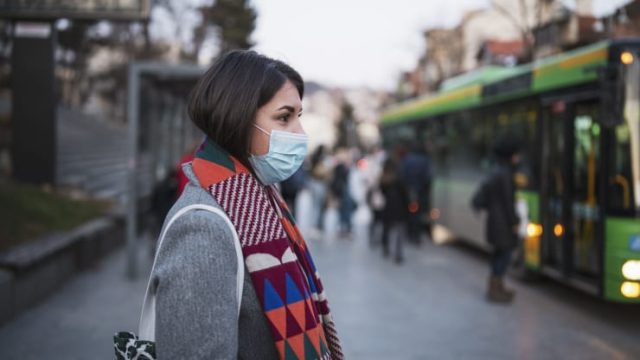
Getty Images / ArtistGNDphotography
With the crisis-level global mask shortage back from the brink, non-surgical N95 masks are no longer emergency-approved for medical use by the Food and Drug Administration. As former CDC Director Tom Frieden told The Washington Post, it was never entirely clear if buying N95 masks from retailers took away supply from health care professionals, although he cautioned that it might. At this point, we can be more confident that it won’t, as medical institutions are seeing replenished stock of surgical N95 masks, which they’re instructed to use.
Non-surgical N95s are available for the public to purchase and provide those at high risk of developing severe illness with the highest level of protection possible. KN95s tested to the same filtration standard are the next best thing, but they lack the same fit standards, incorporating ear loops rather than tighter-fitting head straps, for example. Our ASTM-certified picks (which similarly use ear loops) also achieved greater than 95 percent filtration in certified testing, and right now, they’re generally easier to purchase than KN95s. One of our picks by 3M can be picked up at your local Target, for instance.
Our favorite N95 mask
Fangtian N95 Respirator Face Mask
Still, finding legitimate, NIOSH-approved N95 masks at reasonable prices can be tough. Suzhou Fangtian’s N95 masks first came to our attention early in 2021 as one of the few reasonably priced N95 masks available for purchase at the time. Apart from the approachable cost, they also stood out for being fully certified NIOSH-approved N95 masks. Referencing both NIOSH’s own approved list of N95 manufacturers and models and the FDA’s list of known counterfeits, we can say that these are solid, legitimate N95 masks. The third-party seller doling out the masks has a 99 percent positive feedback rating on Amazon after more than 80,000 lifetime reviews.
Being N95s, the Fangtian masks use head straps as opposed to ear loops, and they provide a snug fit for medium to large face sizes. This fold-flat “duckbill” style makes for easy storage and an excellent fit for a wide variety of facial contours, thereby minimizing unfiltered airflow. The nose wire is malleable yet sturdy, and it has a thin foam lining along the inside of the mask for better comfort along the nose bridge. This also helps to stop the gapping that often occurs with masks around the nose area. The end result is a glove-like fit around the face with no noticeable leaks.
These masks are a particularly great deal now at $13 for a pack of ten, down from $40 when we first recommended them, thanks to increased PPE supplies.
A great KN95 mask
KN95 Respirator Face Mask
KN95 masks have often been called the Chinese equivalent of N95s. Although filtration efficacy may be similar, fit, durability, and many other factors separate the two mask types. Still, KN95s can be a worthy alternative for public use, since the FDA no longer authorizes their use in health care settings.
For the public, they’re a great alternative to the more fixed nature of N95s, as their ear loops make them much easier to take on and off than the head straps of an N95 allow. Even better, they’re much lower on the list of masks that could be called on again for emergency use in health care settings. KN95s from various manufacturers have been tested by NIOSH for filtration efficacy; the main challenge is finding quality KN95s to buy.
Dongguan Arun’s KN95s have been on our list since the prior update to this guide in March. Not only is their nose wire sturdier than those of most other KN95s we’ve tested, but the shape and less rigid construction of the mask itself allows for a better seal than most competing options. Arun’s masks were previously tested and included in the FDA’s (now revoked) emergency-approved non-NIOSH respirators for health care workers. The tests showed a maximum filtration efficacy of 100 percent and a minimum of 95.22 for this model.
The fit on these tends to favor somewhat larger face types, so if you’re on the smaller side, our pick for an ASTM-certified disposable mask might suit you better while offering the same protective properties.
A high-filtration ASTM-certified mask
3M Advanced Face Filtering Mask
Among the masks tested to the new ASTM F3502-21 Standard for Barrier Face Coverings, 3M’s Advanced Face Filtering Mask rises to the top for its 99 percent particulate filtration efficiency. It’s important to remember that, unlike N95s that are tested for leakage and fit, ASTM’s F3502 standard tests only for the filter materials’ efficacy and breathability. Thus, the 99 percent figure isn’t representative of real-world use as an N95 mask’s minimum filtration measurement of 95 percent (which does account for differential pressure, fit, leakage, and more). Furthermore, the filtration tests themselves differ slightly, so this isn’t an apples-to-apples comparison. Still, the new ASTM standard provides useful results for efficacy in blocking sub-micron particulates, the figures of which are listed on the CDC’s website.
Like KN95s, 3M’s mask uses ear loops rather than head straps. Each mask includes a plastic hook that can hold the ear loops together behind your head to create a similar fit to a head strap-equipped mask, however. I preferred wearing mine that way as it enhanced the mask’s seal around my face. Compared to N95s that use head straps to achieve a better fit, this hook is much easier to undo and redo when I’m in situations where easier removal is needed.
The nose wire is sturdy and malleable, although the angle at which it bends is rather sharp. It may take a bit of molding to achieve an ideal fit along the nose bridge. These masks aren’t a great choice for larger face sizes, either, but they should fit well on small to medium face types.
ASTM-certified, US-made surgical masks (with a mask brace)
Armbrust Better Mask High Filtration System
Armbrust’s Better Mask High Filtration System helps you to use a single surgical mask at its highest efficacy. Generally, it’s recommended to use a surgical mask in tandem with a more form-fitting cloth mask over it (see our section on double-masking below). This improves fit and adds another layer of protection from liquids. But using a surgical mask with a mask fitter is another option for creating a tight seal and bolstering surgical masks’ filtration properties.
Manufactured at and sold from the company’s Texas-based facility, Armbrust’s system comes with 30 masks and one mask fitter made by Fix the Mask, another US-based manufacturer. Surgical masks use non-woven, hydrophobic materials that have been lauded for their filtration efficacy, and the Armbrust system is no exception. Their masks were able to achieve 97 percent filtration of particulates under 1 micron, according to ASTM F3502-21 results.
Our top pick for an all-around cloth face mask
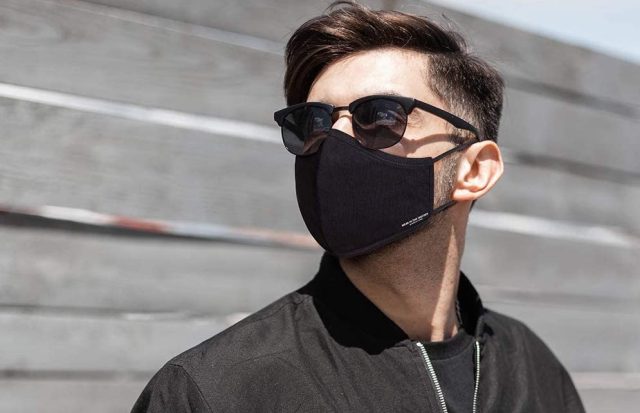
Kenneth Cole
The best mask to limit COVID-19 transmission is the N95 respirator. When we say “top all-around pick,” this means it’s a great mask for the largest amount of people—healthy, low-risk individuals, in particular—with just about every feature noted in CDC/WHO guidelines.
Kenneth Cole Woven Face Mask
What makes Kenneth Cole’s Woven Face Mask our top all-around recommendation is the rare characteristic of not only meeting but exceeding best practices from the CDC and WHO.
With six layers—an inner cotton layer, four non-woven filtration layers, and a moisture-controlled antibacterial outer layer—these masks check all the boxes, some of them multiple times. The antimicrobial treatment on the outer layer shouldn’t be thought of as a SARS-CoV-2-killer, as such claims haven’t been tested, but rather an odor-killing measure for hygiene. This protection starts to diminish after about 30 washes at 140°F, but it’s unlikely you’ll experience much impact from this; you should be washing your mask regularly between wears anyway.
The masks are also machine-washable and have cord locks to tighten the ear loop’s fit, as well as a nose clip to form-fit along your nose bridge and cheeks. Just note, Kenneth Cole sells a variety of masks that use the same basic design outlined above, but we’ve noticed varying fits and nose wire placements between different models. We best liked the rigidity, size, shape, nose wire placement, and adjustable straps afforded by their Woven Face Mask and Days of The Week Face Masks.
Kenneth Cole’s Woven and Days of The Week masks aren’t the only worthwhile masks—our next pick, for instance, has our favorite overall fit—but as far as cloth masks go, they’re exemplary representations of all the CDC and WHO’s requirements.
Great masks for double masking, use with replaceable filters, and glasses wearers
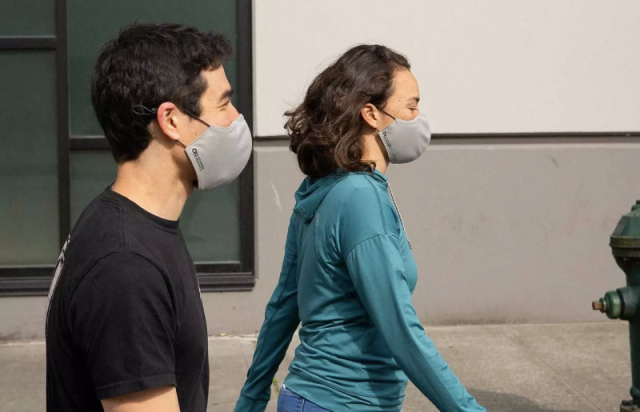
Outdoor Research
Outdoor Research Mask Kit
Cloth masks designed for use with replaceable filters can be a better long-term solution for keeping out potentially harmful particles than relying on a mask that comes with a filter sewn in. As any breathable material begins to wear, effective filtration inevitably becomes affected. That wear is only exacerbated after multiple washes. While you should still remain vigilant for signs of wear on masks with replaceable filters, the ability to swap in brand-new filters with each use means you won’t have to question the integrity of your primary filtration layer. We have two main picks here, both with disposable filters, though the former has been tested to a higher filtration standard.
The Face Mask Kit by Outdoor Research is my personal favorite cloth mask, and it would be our top pick if it had a sewn-in filter for added convenience. The all-in-one nature of the Kenneth Cole mask makes it less of a hassle to maintain—and introduces less room for user error—but outside of that important caveat, Outdoor Research’s kit ticks all the same boxes, but better.
This mask has the best fit of all the options we’ve tried, including many that didn’t make this list for other reasons. The nose wire is exceptional: it has a sturdier, longer, and more rounded shape around the nose bridge—which helps to seal off the area properly and eliminate air leakage—compared to any mask we’ve tested, with just the right amount of malleability. This creates a comfortable and effective seal along the nose bridge and cheekbones, which is especially beneficial for glasses wearers.
The shape and structure of the Outdoor Research mask fit my face as well as any cloth mask I’ve tried, sealing my cheeks and chin snugly without excess airflow. It’s still a very breathable mask, though, even with the filter inserted. That filter spans the entire inside and uses the mask’s excellent fit to seal itself well on your face. Adjustable ear loops bolster the comfortable fit. All of this makes the Outdoor Research Face Mask our top pick for use with double masking, with or without the disposable filter, and my personal go-to for cloth masks.
The filters are made of non-woven polypropylene, which is the same material used in medical masks. They meet the ASTM F2100-2019 standard for filtration efficiency, which means they’re rated to filter out greater than 95 percent of bacteria sized 0.1μm or bigger. SARS-CoV-2 viral particles can range in size from 0.5μm to less than 0.1μm. PM2.5 filters, which are commonly sold online for those sensitive to air pollution, won’t be as effective—they only filter out particles up to 2.5μm. The ASTM F2100-2019 standard also tests for differential pressure (the amount of air escaping or passing through the filter), flammability, and resistance to synthetic blood penetration. Outdoor Research’s filter meets or exceeds all but the test for blood penetration, which is made specifically to simulate a patient’s artery or vein bursting onto the mask—a highly unlikely situation for members of the general public to find themselves in.
The company says its filters can be used for around five to seven uses and are not to exceed 40 hours in a week, depending on humidity, face makeup, facial hair, and sweat. Per CDC guidelines on reusing medical masks, implementing a rotation policy where you use multiple masks with at least five days in between each wear could be a useful strategy to prolong the filters’ life span. This should be safer than washing the mask every day and transferring the partially used filter into the freshly laundered mask.
The Outdoor Research masks should always be worn with the filter inserted, as they’re only composed of two layers of polyester otherwise. While this material is great for breathability and water repellence—two qualities the WHO recommends in a mask—its filtration efficacy alone won’t provide much protection without the filter. In combination with the disposable filter, though, the polyester’s low moisture retention and therefore higher electrostatic properties could help catch aerosols. Three filters come with the mask, and replacements can be bought in relatively inexpensive three packs.
Without the filter inserted, the face mask is machine-washable at high temperatures, which is another great plus, and it’s treated with HeiQ V-Block, which starts to diminish after about 30 washes. As we mentioned with other masks using this coating, this is mostly to prevent odor-causing microbes from thriving.
Another good option
Kitsbow Reusable Face Mask with HEPA Type Filter
Kitsbow’s Reusable Face Mask with HEPA type filter has many of the same characteristics as Outdoor Research’s Face Mask Kit, but it uses elastic head straps as opposed to ear loops. The mask’s structure wraps around your cheeks and chin snugly, and the nose wire is sturdy but properly malleable and rounded for proper fit. It doesn’t give me the same tailor-made feeling I get wearing the Outdoor Research mask, and the nose wire isn’t as long and expansive over the cheeks, but it’s a design that’s still likely to create a good seal over multiple face types, including my own. Small, medium, and large options are available.
Two “HEPA Type” filters are included with the mask, but the company makes no claims as to their filtration. The New York Times’ Wirecutter did some lab testing of its own, however, and found the mask without the filter to have a higher filtration than their top pick without its filter. Adding in the filter should only bolster its efficacy, but since there’s little data on the filters themselves, we recommend using the Kitsbow mask (with or without the filter) as the outer layer in a double mask setup.
Its large surface area does well to cover any gaps in a disposable mask worn underneath, while also adding useful layers of filtration and protection on top.
A great mask for runners and exercisers

Under Armour
For those who need a comfortable, breathable, water- and sweat-resistant mask that doesn’t get sucked into your mouth during light or heavy exercise, the UA Sportsmask developed by Under Armour is the perfect fit.
Composed of three layers, the UA Sportsmask has a water-resistant polyester outer layer, a 100-percent polyurethane middle, and a soft, smooth inner layer made of 77-percent nylon and 23-percent spandex for wicking away moisture. It’s also machine-washable.
The structure of the mask also ensures that it sits raised off of your face and lips. Not only does that arrangement enhance breathability and maximize filtration efficacy, but it also provides excellent comfort by avoiding contact with sweaty skin, and it prevents the mask from being sucked in during heavy breathing. The form-fitting nose piece and stretchable ear-loops bolster these aspects while providing a snug fit for limiting air escape.
We’ve seen the UA Sportsmask frequently mentioned as a top pick in running and exercise communities, and with all its safety bases covered, it’s a great choice from a usability and efficacy standpoint as well.
Great masks for people hard of hearing
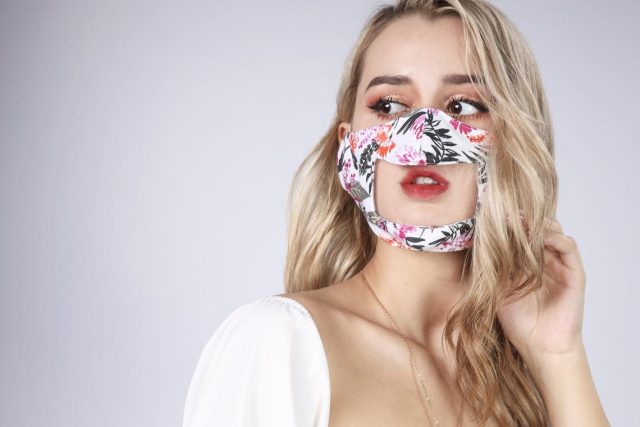
Etsy/Deluxemask
A unique issue now facing people who are deaf or hard of hearing is the inability to lip-read somebody wearing a mask. Ideally, in such situations, it’s best to use handwritten communication, text (or speech-to-text features commonly found on phones and app stores), or ASL. Obviously, pulling down your mask to communicate is not safe, and face shields are not sufficient replacements for masks.
Adult and Kids Window Masks
Instead, the CDC recommends the use of clear masks if you’re regularly communicating with people who have hearing impairments or otherwise rely on facial expressions and cues regular masks hide. Masks made solely of clear materials like vinyl are next to useless, but a cloth mask with a small window of clear material can be a good option.
Generally, a mask without a clear window is optimal for situations when you don’t need a clear window—that’s because clear windows can create slightly more air pressure within the mask, contributing to more air escaping through the sides. However, if you’re a teacher or caretaker, for instance, who is required to communicate with people in need of such a solution for long hours, then a windowed mask is your best bet.
Windowed masks are still a relatively new market for mask makers, and as such, you won’t find many that meet CDC/WHO standards from big manufacturers or your typical marketplaces like Walmart and Amazon. Instead, it has become incumbent upon the craftier among us to help meet this need and do so up to spec. The CDC has released guidelines on how to create good masks at home, but if you’re not particularly handy, your best bet may be to pick a mask that exceeds these standards and is made by someone with nimble fingers.
The clear window masks by Bonnie’s Crafty Creations tops our picks thanks to its three-layer cotton design, built-in nose wire, and adjustable straps. We also love how its large window area doesn’t take up too much of the mask’s sides, where fabric is preferable. Machine-washing this or any other mask with a clear window is not recommended, but hand-washing is entirely suitable. Fog protection on a Clear Window Mask is solid, but if that does begin to wane, you can rub a dab of dish soap, toothpaste, or anti-fog spray on the inside to help prevent fog.
There’s also a nice assortment of styles, from plain to, well, not-so-plain and a few in between. There are also options for kids with a ton of fun pattern selections. Best of all, for those who use hearing aids, the majority of these masks come with elastic straps that fit around the head rather than around the ears. These can be cut and fashioned into ear loops if desired. Do note that some of the masks sold by Bonnie’s Crafty Creations offer the option to add vents—something we’ll stress again that you should avoid at all costs.
Great masks for kids

These masks have a variety of cotton materials with fun kids’ patterns, from school subjects to superheroes. All have three layers with a filtration layer in the middle.
Getty
Kids Face Mask by Bonnie’s Crafty Creations
In looking for a mask for a little one, the same rules apply as for yourself. As such, you can choose from any of the above options, depending on your needs, and select kids or a smaller-sized option. Most manufacturers’ sizes in small/medium fit children, while the majority of adults should fit in large/extra-large offerings.
If you’d like something a bit more playful but still every bit as protective, we think one of the window-less options from Bonnie’s Crafty Creations is a solid bet. Styles range from superheroes to school subjects, and there are animated characters of all kinds, so self-expression shouldn’t be an issue here.
Even better, these masks have two layers of cotton sandwiching a third layer made of Pellon, a 100-percent polyester material. They also feature an adjustable nose wire and are machine-washable for ease of wear and maintenance. Some of these have options to add valves, but we can’t stress enough how important it is to avoid using such masks.
Great accessories for a better mask fit
As we mentioned in earlier sections, using a disposable medical procedure mask with an enhanced fit is an effective way to limit exposure and spread, ideally, used concurrently with a well-fitting cloth mask worn over it. Tying off and folding in the flaps of disposable masks properly is one studied way of improving the fit of disposable masks, but a rubber brace can help, as well. This was the thinking behind FixTheMask’s Essential Mask Brace. Founded by a former Apple engineer, the company manufactures rubber braces to ensure a tighter facial seal when using disposable masks. The website also offers a free downloadable template to create your own.
It’s best to wear a cloth mask over your disposable one, such as the aforementioned Outdoor Research Face Mask Kit or Kitsbow Reusable Face Mask—our two favorite picks for double masking.
Cord locks
Most of our mask picks have adjustable ear loops, but for those that don’t, such as the KN95s or our pick for a clear window mask, cord locks are a useful addition. They’re relatively easy to thread onto your ear loops and stay in place well enough to create a more secure fit. We don’t recommend using cord locks in lieu of knotting and pleating a disposable mask in a double mask configuration, as it can be hard to tighten if it becomes loose under your second mask, but as a fit enhancer for your primary mask, these can save you from drooping or less-than-ideal-fitting masks you purchase, especially since they’re typically non-returnable.
A quick word on the new NIOSH criteria for (non-medical) workplace masks
The National Institute for Occupational Safety and Health (NIOSH) recently provided criteria for a new standard of masks meant for non-medical workplace settings. Masks tested to this standard can meet one of two levels: Workplace Performance and Workplace Performance Plus. The specification uses ASTM standard F3052-21, which tests masks for filtration of sub-micron particulates and wearer breathability, but NIOSH adds another metric for leakage, called the leakage ratio.
The leakage ratio is tested using a modified version of 29 CFR 1910.134, the same standard used to test N95 masks, among other OSHA-approved respirators. To be considered a Workplace Performance mask, a mask must have a leakage ratio of greater than or equal to 5, a filtration efficacy of sub-micron particles greater than or equal to 50 percent, and compliance with ASTM F3052-21’s Level 1 breathability metric. Masks with leakage ratios greater than or equal to 10 (the higher, the better), Level 1 breathability, and greater than or equal to 80% particulate filtration meet the standard of Workplace Performance Plus.

CDC/NIOSH
This is a newer, optional standard for consumer mask manufacturers to use, so the list of masks using this standard is still small. Results from the tests can be found on the CDC’s website. We’ve chosen a couple of masks from this list as our top picks above, taking into account all three aspects of NIOSH’s criteria.
A note on the science of face masks

As a disease that has only come to our knowledge in the past couple of years, the epidemiology and pathology of COVID-19 is still relatively nascent compared to pathogens we’ve had decades, or even centuries, to study. As much as we at Ars wish we could contribute to pushing this research further along, we don’t have the tools to research various masks and their impact on COVID-19 transmission as deeply as we (and the entire scientific community) would like to. As such, we’re reliant on the latest scientific discoveries and the long-understood knowledge that, generally, a proper mask limits pathogens from entering or escaping the respiratory system where they can be absorbed and expelled.
Historically, the science behind mask-wearing has consistently pointed toward having a positive effect on slowing/preventing transmission of airborne diseases. For some of us, that’s all we needed to know when it came time for the public to adopt transmission-slowing measures during the current COVID-19 pandemic. But at first, leading health organizations like the WHO and CDC both had trepidations about recommending universal masking.
In summary, the reasoning against wearing them at first boiled down to an absence of evidence, supply shortages for health care workers, and the fear of masks providing a false sense of security to the detriment of the public’s adherence to other important aspects of reducing transmission, like social distancing, limiting gatherings, and diligent hand-washing. At this point, it has been proven—time and again—that masking is an effective measure against COVID-19 transmission. The global mask shortage has finally rebounded significantly. And even now that there are vaccines to (greatly) further protection, there’s still a seemingly immovable portion of the population that simply doesn’t care what the science says. Nevertheless, by now it’s clear that masks will continue to be an important tool in slowing transmission and—hopefully, one day—ending the pandemic.
Shouldn’t this list just be N95s and equivalents?
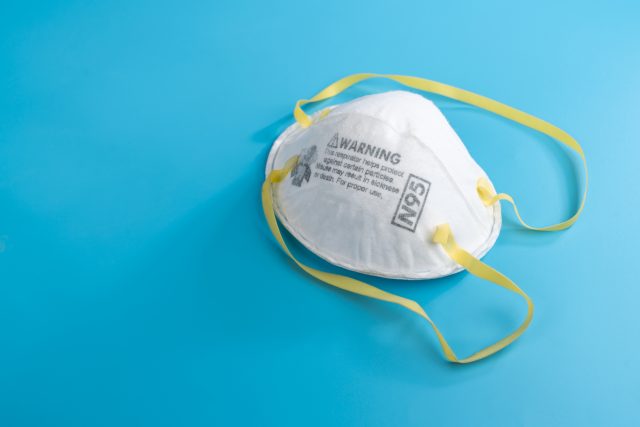
Not exactly.
At the beginning of the pandemic, a global shortage of PPE forced health care systems, regulation agencies, and the general public to adopt measures of conservation for health care workers treating COVID-19 patients. As the pandemic roared on, it wasn’t long until this shortage was compounded by supply chain issues and a market rife with counterfeits.
Recently, PPE availability has finally come out of the red, and agencies like the FDA have revoked a few of the Emergency Use Authorizations (EUA) aimed at putting legitimate protection in the hands of health care workers. Within those EUAs are lists of imported disposable filtering facepiece respirators (FFRs)—that is, disposable masks—that the FDA approved for use in health care settings.
The lists predominantly feature popular models like China’s KN95 and Korea’s KF94 face masks, sold by various brands and tested for filtration efficacy by the NIOSH National Personal Protective Technology Laboratory (NPPTL). Using a modified version of NIOSH’s filtration standard for N95 masks, the tests focused solely on filtration efficacy, not fit and durability (among other tests), as NIOSH-approved N95s are typically tested in non-crisis circumstances.
Masks that were found to meet their claims of a minimum 95 percent particulate filtration for particles 0.1μm or bigger were approved for use in health care settings due to the crisis-level need for PPE. Though many were tested, not all were approved. As of July 6, 2021, those that didn’t make the cut were banned from use in health care settings.
The revocation of this EUA means that medical institutions must now seek only NIOSH- and FDA-approved surgical N95 masks for their personnel. What that means for the public is that, at this time, there is no longer cause for concern with potentially taking away N95-equivalent masks from health care workers. Essentially, any KN95s, K94s, or other N95-equivalents that tested well on these lists are fair game for consumers to buy.
While stock on NIOSH-approved N95s has also improved, using them exclusively for day-to-day activities is both impractical and unnecessary in most cases. Non-health care workers should never purchase surgical N95 masks that are specially labeled as such. But having a stock of non-surgical N95s for particularly risky situations where social distancing can’t be observed, like taking public transportation or other similarly fraught indoor activities, is advisable for the general public. In particular, N95s are recommended in all situations for those who are over the age of 60, those who have underlying conditions, those caring for someone who is ill with COVID-19, or people who are themselves feeling unwell, according to WHO and CDC guidance.
If you’re regularly in high-risk situations, like if you work in a public-facing job and you’d like to primarily use N95s or equivalents, see our section on how to reuse these masks safely.
How to double mask effectively
According to a recent CDC study, doubling up a disposable medical procedure mask with a cloth one can lower exposure to particles sized 0.1–7 μm (the typical range of SARS-CoV-2 particles) by about 83 percent when the exposure source is unmasked, and 96 percent when the exposer and subject are both masked. When the subject was wearing a single cloth or disposable mask alone, results showed the face coverings blocking only around 50 percent for each. Similarly, tucking and knotting a single disposable mask in the technique demonstrated by the CDC reduced the source’s emission of particles by 77 percent in a simulated cough and protected a wearer from an unmasked source at about 65 percent efficacy.
The obvious takeaway here is that whether you’re the source of viral particles or the potential recipient, double masking combined with knotting and tucking appears highly effective for source control and exposure—particularly when both subjects are double masked.
Pulling off double masking is relatively easy, but a key aspect of this is tying knots in the disposable mask’s ear loops (layer one) and tucking in the folds on the side to achieve a better seal. The trick here is to make sure you tie the knot as close to the mask piece as possible to ensure the folds stay tightly tucked when wearing. To do this, follow the steps below.
- Wrap an ear loop around your finger and pull the strap through under itself on your finger.
- Slide the knot all the way down to the fabric of the mask before removing your finger and tightening.
- Once you’ve done this on both sides, the mask will have raised creases on each side. Tuck these inward and press flat on the inside of the mask so this new pleat creates a flat seal.
Click through the slides below to see the steps and final product.
-
Wrap an ear loop around your finger.
Corey Gaskin / Ars Technica -
Pull the strap through under itself on your finger.
Corey Gaskin / Ars Technica -
Slide the knot all the way down to the fabric of the mask before removing your finger and tightening.
Corey Gaskin / Ars Technica -
Once you’ve done this on both sides, the mask will have raised creases on each side.
Corey Gaskin / Ars Technica -
Tuck the creases inward.
Corey Gaskin / Ars Technica -
Press flat on the inside of the mask so this new pleat creates a flat seal.
Corey Gaskin / Ars Technica -
The finished product.
Corey Gaskin / Ars Technica
You can also achieve similar fit improvements with mask braces or by pulling “a sleeve made of sheer nylon hosiery material” over the mask, according to the CDC. Once you have an improved fit from your disposable mask, affix it to your face and simply wear your best-fitting cloth mask over it. Not only does this enhance filtration, but an excellent-fitting cloth mask will help shore up any remaining gaps from the disposable mask underneath.
See our picks above for the masks we found best compatible with double masking.
How to choose a mask
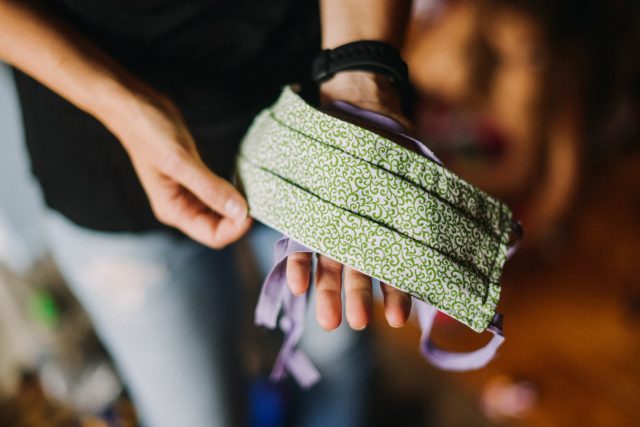
Stefania Pelfini, La Waziya Photography / Getty
When shopping for a good cloth mask, there are a few dos and don’ts to keep in mind, put forth by the WHO and CDC. Here’s the summary.
DO
- Look for masks with at least three layers as outlined below.
- An innermost layer made of hydrophilic (water-absorbing) material (cotton or cotton blends).
- The outermost layer made of hydrophobic (water-repelling) material (polypropylene, polyester, or their blends).
- A hydrophobic middle layer of synthetic non-woven material such as polypropylene or another cotton layer that may enhance filtration or retain droplets.
- Ensure a good fit with a tight seal. Form-fitting wires in the nose bridge are especially helpful.
- Make sure it fits snugly but comfortably against the sides of the face and completely covers the nose and mouth.
- Choose masks secured with ties or ear loops.
- Make sure it allows for breathing without restriction.
- Select materials that can be laundered and machine dried without damage or change to shape.
DO NOT
- Don’t get valved masks. They put others at risk.
- Don’t use fabrics coated in wax or other similar compounds on any layer of the mask, as these can block the mask’s pores for airflow, creating more air pass-through around the sides of the mask.
- Don’t get masks made of stretchable fabrics, as these increase pore size as they stretch.
- Don’t use neck gaiters for the following reasons:
- They’re typically made of stretchable fabric.
- Often they don’t have the proper number or types of layers.
- It’s hard to keep track of where the front is to avoid touching it.
Sticking to these guidelines will help to ensure efficacy, reusability, and safety for yourself and others.
How to practice good mask hygiene
Putting on, or donning, a clean mask is a relatively simple process. In an ideal scenario, you would sanitize your hands or wash them for at least 20 seconds. Then, holding the ties or ear loops, put the mask on your face and ensure a good seal around the nose bridge, cheeks, chin, and sides of your face.
While you’re wearing the mask, avoid touching the front of it, as there can be viral particles on the surface. By now, you’ve likely heard not to touch your face (or nose, mouth, and eyes) to avoid potential infection via fomite transmission of the virus, caused by touching a surface that may be contaminated with it and introducing it to your body. While wearing your mask, the front of it especially should be treated as a potential fomite (source of transmission), so ensure proper fit when putting it on initially to avoid having to touch it while wearing.
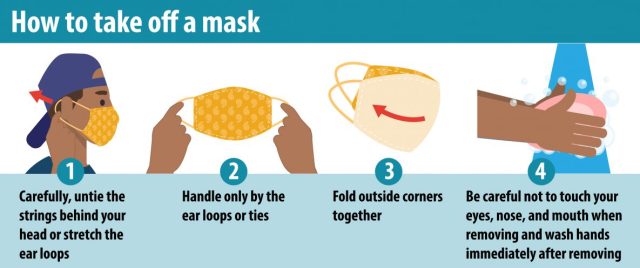
CDC
This continues when you’re taking off the mask, or “doffing” it, as well. Grasp only by the ear loops or ties, undo them, and remove the mask downward off your face, taking care to avoid contact with the front of the mask. Immediately place your mask in a plastic or paper bag, or throw it directly into the wash after wearing it. Most masks are OK to put in with other high-temperature washable clothing (more on this in the next section). If you’re unable to launder the mask immediately, make sure to fold it inward so the inner part (where your face was touching) is facing out when placing it in a single disposable bag. Wash your hands for at least 20 seconds (or sanitize them) directly after doffing the mask.
Try to avoid donning and doffing your mask multiple times throughout one wear. Masks should be washed or sanitized after every use. For this reason, it’s helpful to have multiple masks to suit your wearing habits such that you’re never wearing a contaminated mask. Any masks exposed to outside liquids or other damage should be taken off and discarded as soon as it’s safe to do so. If the layers of fabric look noticeably worn out or you notice any holes forming, discard the mask.
To summarize:
- Before putting on your mask, wash your hands for at least 20 seconds (or sanitize them).
- Secure the mask on your face and ensure a snug, breathable fit with the best seal possible.
- Avoid touching the front of the mask while wearing it or taking it on and off multiple times throughout the wear.
- Take the mask off by the ties or ear loops and put it directly in the wash.
- OR place it in a disposable bag until it can be laundered.
- Sanitize or wash your hands for at least 20 seconds after taking off and laundering/storing your mask.
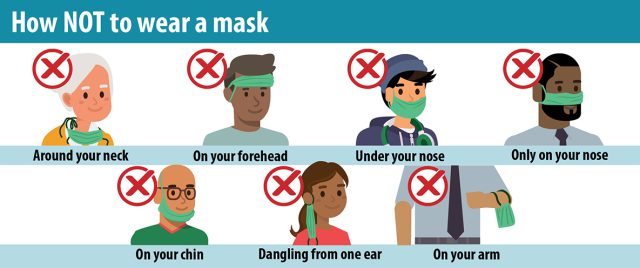
CDC
How to wash a face mask
Generally speaking, you should follow the washing or sanitizing instructions provided by the manufacturer of your mask. Do not put masks in microwaves or ovens or attempt to use UV light to sanitize your mask. These are neither safe nor effective ways to kill all the germs on your mask. There are currently no consumer products on the market—UVC-emitting, heat-radiating, or otherwise—that can achieve sterilization of any type of mask.
If you don’t have laundering instructions for your mask, here are some general guidelines you can follow to wash your fabric mask safely and effectively.
Machine-washing
- If machine-washable, include your mask with your regular laundry.
- Use regular laundry detergent and the warmest water the materials permit.
- Ideally, your mask’s materials should be able to withstand 140° Fahrenheit (60° Celsius).
- Non-woven polypropylene may be washed at high temperatures, up to 140°C.
- Masks composed of non-woven polypropylene spunbond fabric combined with cotton can tolerate high temperatures and can therefore typically be steamed or boiled.
- Wash these masks delicately without too much friction, stretching, or wringing.
- If hot water isn’t available, wash with soap or detergent and room-temperature water, followed by either boiling the mask for one minute (if made of the proper materials) or soaking it in 0.1 percent chlorine for one minute, then thoroughly rinsing with room-temperature water to avoid any toxic residual of chlorine.
Washing by hand
- Use bleach containing 5.25 percent–8.25 percent sodium hypochlorite. Don’t use bleach outside of this range or if it’s not specified.
- Check the label to see if the bleach is intended for disinfection. Some bleach products, like those made for color-safe use, don’t meet the needs for disinfection.
- Don’t mix bleach with other cleaners.
- Ensure adequate ventilation during use.
- Wear skin protection and consider eye protection for potential splash hazards.
- Prepare a bleach solution by mixing:
- 5 tablespoons (1/3rd cup) of 5.25 percent–8.25 percent bleach per gallon of room-temperature water
- OR 4 teaspoons of 5.25 percent–8.25 percent bleach per quart of room-temperature water
- Soak the mask in the bleach solution for 5 minutes.
- Pour the solution down the drain and rinse the mask thoroughly with cool or room-temperature water.
Drying
- Use the dryer’s highest heat setting and leave the mask in until completely dry.
- OR allow the mask to air dry completely, placing it in direct sunlight if possible.
After washes, make sure to inspect the mask for any signs of damage or developing holes. Like anything made of fabric, over time, it will start to degrade. Staying vigilant here will let you know when it’s time to get a new mask, especially if the manufacturer doesn’t state an estimated lifetime.
How to reuse disposable masks responsibly
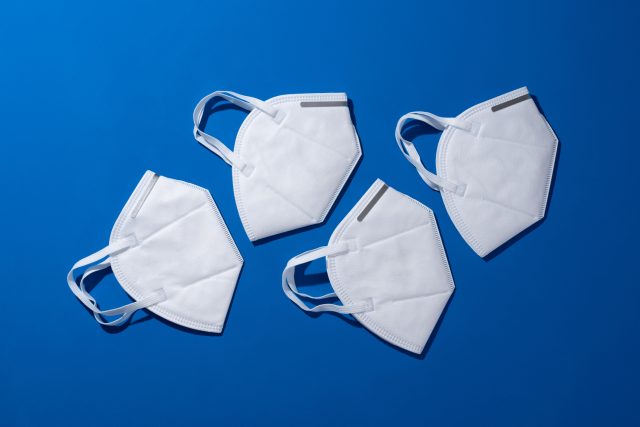
MirageC / Getty Images
During times of crisis, the CDC authorizes decontamination and reuse strategies to preserve stock of disposable medical masks. Since we’ve turned the corner on the global mask shortage, the agency no longer recommends implementing such strategies for health care workers. Still, a modified version of this strategy can help you get longer and safer use out of your disposable N95 and equivalent masks. Surgical masks—i.e., the flat blue ones with pleats—are not included in this method.
In crisis circumstances, the CDC says N95 masks can be used on up to five separate occasions and are not to be worn for more than eight hours total. Studies show that, past these benchmarks, the integrity of the mask, and in particular its fit, has degraded beyond a safe point for use. To ensure integrity, users should perform a seal check with each reuse.
If you’re following these procedures, a rotation policy that allows at least a week between each mask’s use is highly advisable. Between uses, you should store the masks in individual, breathable paper bags. This helps limit the potential for fomite transmission from a contaminated mask and extends the use of your N95 or equivalent.
These masks aren’t rated for duration of use, as they’re manufactured to be used once and disposed of when taken off. But the CDC indicates that following these guidelines, as well as those outlined above for taking off PPE safely, can allow users to safely use the same mask on multiple occasions before disposing.
Searching online for methods to sanitize disposable masks will yield some results, including previously approved (but now revoked) CDC/NIOSH-endorsed methods for health care facilities, specifically those facing crisis-level respirator shortages. Crucially, though, only certain health care facilities had the proper tools to effectively use these minimally studied strategies for sanitizing disposable medical masks. So don’t try to mimic any of that at home—you can’t. The prescribed rotation policy is your best bet.
There are currently no consumer products on the market—UVC-emitting, heat-radiating, microwaving, or otherwise—that can achieve sterilization of any type of mask.
Listing image by Getty Images / ArtistGNDphotography

